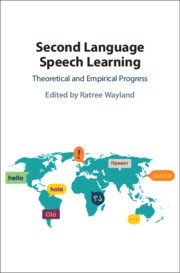Book contents
- Second Language Speech Learning
- Second Language Speech Learning
- Copyright page
- Dedication
- Contents
- Figures
- Tables
- Contributors
- Preface
- Acknowledgments
- Part I Theoretical Progress
- Part II Segmental Acquisition
- Part III Acquiring Suprasegmental Features
- Part IV Accentedness and Acoustic Features
- Part V Cognitive and Psychological Variables
- Chapter 16 Self-Reported Effort of Listening to Nonnative Accented English Depends on Talker Pausing and Listener Working Memory Capacity
- Chapter 17 Investigating the Role of Cognitive Abilities in Phonetic Learning of Foreign Consonants and Lexical Tones
- Chapter 18 Auditory Priming Effects on the Pronunciation of Second Language Speech Sounds
- Chapter 19 Indexical Effects in Cross-Language Speech Perception
- Chapter 20 The Role of Orienting Attention during Perceptual Training in Learning Nonnative Tones and Consonants
- Index
- References
Chapter 16 - Self-Reported Effort of Listening to Nonnative Accented English Depends on Talker Pausing and Listener Working Memory Capacity
from Part V - Cognitive and Psychological Variables
Published online by Cambridge University Press: 21 January 2021
- Second Language Speech Learning
- Second Language Speech Learning
- Copyright page
- Dedication
- Contents
- Figures
- Tables
- Contributors
- Preface
- Acknowledgments
- Part I Theoretical Progress
- Part II Segmental Acquisition
- Part III Acquiring Suprasegmental Features
- Part IV Accentedness and Acoustic Features
- Part V Cognitive and Psychological Variables
- Chapter 16 Self-Reported Effort of Listening to Nonnative Accented English Depends on Talker Pausing and Listener Working Memory Capacity
- Chapter 17 Investigating the Role of Cognitive Abilities in Phonetic Learning of Foreign Consonants and Lexical Tones
- Chapter 18 Auditory Priming Effects on the Pronunciation of Second Language Speech Sounds
- Chapter 19 Indexical Effects in Cross-Language Speech Perception
- Chapter 20 The Role of Orienting Attention during Perceptual Training in Learning Nonnative Tones and Consonants
- Index
- References
Summary
This study was designed to investigate the contribution of non-native (L2) patterns of pausing to the perceived effort of listening to speech. English-language speech samples from ten native speakers of Korean and Mandarin Chinese (five of each) previously assessed as having intermediate proficiency in English were manipulated by removing all non-juncture silent pauses as well as all filled pauses. The original and manipulated speech samples, as well as samples of comparable but un-manipulated English speech produced by ten native speakers of Korean and Mandarin Chinese with higher English proficiency were evaluated in a between-groups design by 60 native speakers of American English. Although the removal of non-juncture pauses did not significantly alter listeners’ ratings of the intermediate speech, results did suggest a subtle interaction between ratings of effort and measures of listeners’ working memory capacity, suggesting that the detrimental effects of pausing in non-native accented speech may be related to increased demand on limited-capacity cognitive processing resources such as working memory.
- Type
- Chapter
- Information
- Second Language Speech LearningTheoretical and Empirical Progress, pp. 399 - 417Publisher: Cambridge University PressPrint publication year: 2021



